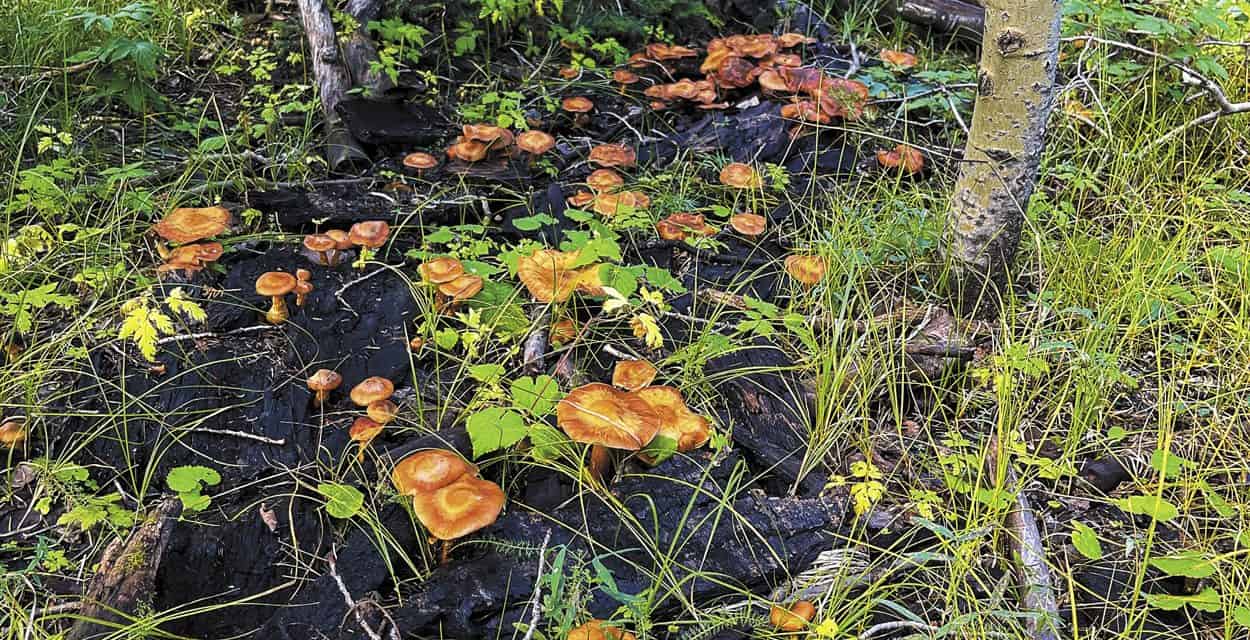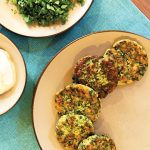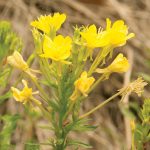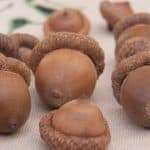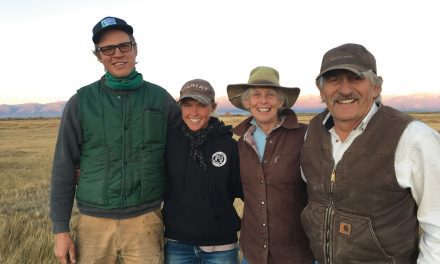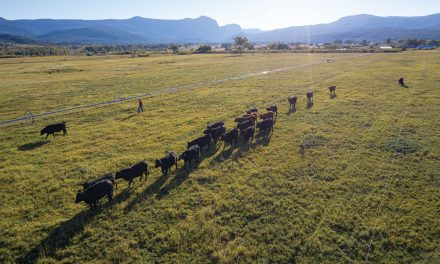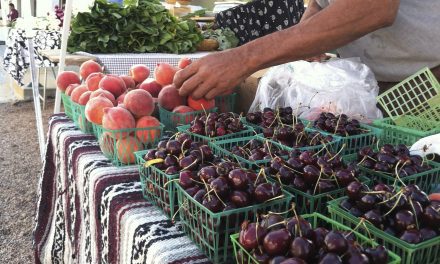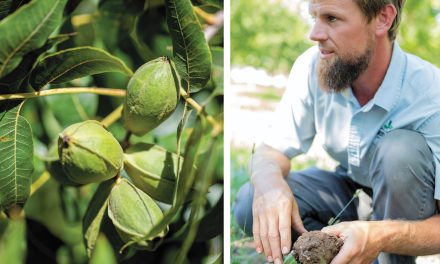Beauty, Flavor, and Science Converge on a Taos Foray
By Ellen Zachos · Photos by Stephanie Cameron

Honey mushrooms on dead hardwood in a huge fungal flush.
Hawk’s wing, club coral, lobster, velvet foot, puffball, hedgehog . . . these are names that make the mushroom hunter’s heart go pitter-pat. If they sound unfamiliar to you, maybe you should join the New Mexico Mycological Society (NMMS).
The most anticipated event sponsored by the NMMS is their annual mushroom foray, where enthusiastic mycophiles gather to celebrate the wide range of fungi found in northern New Mexico. I’ve been mushroom hunting for years, but as a transplant to New Mexico I have plenty to learn about Rocky Mountain fungi. I was surprised when longtime member Terri Wallis described New Mexico’s mushrooms as unusually diverse, because I assumed our dry climate would limit mushroom diversity. Most people, including myself, think of places like the Pacific Northwest and the temperate rain forests of the mid-Atlantic when they think of mushroom diversity.
Ah, but mushrooms are temperamental creatures; they require a specific combination of moisture and temperature in order to fruit. (The “toadstool” part of the mushroom is the fruiting body of the fungus.) Some places, such as Pennsylvania, which gets forty inches of rain spread throughout the year, may have less mushroom diversity than northern New Mexico, which gets a mere fourteen inches of rainfall on average. How is that possible? It’s all in the timing. A solid monsoon season delivers concentrated rain in a short amount of time, providing moisture exactly when the temperatures are perfect for fungal growth.
Thanks to this year’s generous rains, field trip leaders at the late-August foray expected us to find a great diversity of species, and we were not disappointed. Before heading off into the mountains early Friday morning, we were given waxed paper bags for collecting specimens (paper bags can fall apart if mushrooms are wet, and plastic bags don’t breathe, so mushrooms may turn to mush) and instructed on how to record the GPS coordinates of where we found each specimen. Because Friday was all about science.
Upon returning to the conference center in Taos, we unpacked hundreds of mushrooms and spent the next few hours working to identify what we’d found, using field guides and peppering our field trip leaders and two foray mycologists with questions. It’s just as important to know which mushrooms are toxic as it is to know which are delicious. For obvious reasons.
We brought in several lovely-looking species that were not on anyone’s menu. Russula emetica is a fragile red mushroom with pure white, delicate, thinly spaced gills. The species name (emetica) tells you everything you need to know: this mushroom will make you vomit. The death cap mushroom (Amanita phalloides) warns you with its common name, and its cousin, Amanita muscaria (the “Alice in Wonderland mushroom”), is a known hallucinogen. It has a history of use in religious ceremonies in Siberia, but I value A. muscaria as an indicator species; it often shares habitat with porcini (in New Mexico, Boletus rubriceps), a choice edible.

1) Club coral. 2) Hawk’s wing. 3) Floccularia luteovirens, commonly known as the yellow mushroom.
4) Amanita muscaria (the “Alice in Wonderland mushroom”). 5) Lobster mushroom. 6) Coprinus comatus, off-white in color when fresh, deliquesces in a matter of hours, turning into an inky-black mass of goo. All specimens collected at the 2022 New Mexico Mycological Society Foray.
My favorite find of the day was Hydnellum suaveolens, a toothed fungus with a smooth white cap and a periwinkle-blue stem. Although this isn’t an edible mushroom, its strong scent reminded me of vanilla, and I couldn’t resist breathing in great gulps of its fragrance.
Friday’s specimens were exhibited for the duration of the foray, giving everyone plenty of time to touch, sniff, and examine more mushrooms than they’d ever seen gathered in one place. Many first-timers were fascinated by the shaggy mane mushroom (Coprinus comatus). Shaped like a closed parasol and off-white in color when fresh, it deliquesces in a matter of hours, turning into an inky-black mass of goo. One learns so much more from handling a physical specimen than from a photo or drawing in a book. Both are helpful, but nothing beats a hands-on experience.
After supper we signed up for the next day’s excursions. Saturday was the main event as far as I was concerned because while Friday was all about science, Saturday was all about food (at least for me).Chanterelles were reported to be abundant above 9,500 feet and I wanted in on the action.
When identifying any mushroom, especially a mushroom you might eat, it’s important to observe the immediate ecosystem. What’s your altitude? Are you on a north- or south-facing slope? Are you in a field or a forest? Many mushrooms have relationships with specific trees. For example, the aspen bolete (Leccinum insigne) gets its common name because it grows among aspens. People disagree about the edibility of this mushroom, with some people reporting GI upset and others having no trouble at all. I’m grateful to fall into the latter category.
Velvet foot mushrooms grow on deadwood. Most puffballs grow in grass. The king bolete, also known as porcini, grows in conjunction with spruce and fir, and honey mushrooms are found on dead hardwood, often in huge fungal flushes. Chanterelles have relationships with several different kinds of trees, including aspens. They often look like they’re growing in grass, but really they’re attached to underground roots.
One of the most beautiful mushrooms I’ve ever seen is the hawk’s wing (Sarcodon imbricatus). The top of its cap has an intricate, feathery pattern of dark brown on beige and the underside is covered with delicate teeth. I want to love this fungus, but to me the flavor is intensely bitter, almost metallic. (Yet I see it on fancy menus and many people claim to love the taste.) I’ve tried everything to make hawk’s wing palatable. Most recently, I scraped off all the teeth, boiled the mushroom for ten minutes, then sautéed the cap in butter with salt and pepper. I took one bite, spat it out, and threw the rest away. From now on, I shall admire hawk’s wing from a distance.

Day two of the New Mexico Mycological Society Foray: in search of edible mushrooms.
New to me was Floccularia luteovirens, commonly known as the yellow mushroom because of its bright yellow cap, which fades with age. It grows among aspens, spruces, and firs, usually in grassy areas. This is a western mushroom that I was happy to add to my repertoire, but I was disappointed when someone said it wasn’t super tasty. Fortunately, I decided to try for myself. I found the flavor of a simply sautéed yellow mushroom to be excellent. Remember, flavor is subjective (witness the hawk’s wing!) and one mushroom hunter’s favorite fungus may be considered only fair by a fellow mycophile.
While many mushroom hunters guard their best spots, our fearless leaders had scouted in advance to make sure we wouldn’t be disappointed. And in the spirit of community that permeated the weekend, people would call out when they came across an especially nice find, offering to share and waiting to harvest until everyone had taken their requisite photos.
Because, as corny as it sounds, that’s what the foray is all about: sharing and education. Each field trip leader is an experienced mushroom hunter with seemingly unlimited patience. They carefully pointed out identification characteristics for each mushroom, making recommendations for edibility or warning against consumption. And when they couldn’t make a field identification, they helped us figure it out when we got back to the conference center and sat down to hunt through a field guide.
There’s a reason they call it mushroom hunting. Mushrooms don’t always appear in the same place every year, the way most plants do. They may not receive the right amount of rain when the temperature is exactly what it needs to be. They may have exhausted all the nutrients in a particular spot. Fire may have destroyed the mycelium that acts as a fungal root system underground. This unpredictability is part of what makes it so incredibly exciting to stumble across the mother lode of king boletes or a giant clump of oyster mushrooms. Sharing that excitement with other mycophiles increases the enjoyment exponentially.
Member after member stressed their commitment to education and sharing information both within the organization and with the general public. Whether you eat the mushrooms you find or simply admire them as gorgeous fungal specimens makes no difference. The NMMS wants you to appreciate and learn your mushrooms so that you can turn around and share the love with the next group of up-and-coming mycophiles. And of course the NMMS also wants you to be safe.

1) Hydnellum suaveolens, a toothed fungus with a smooth white cap and a periwinkle-blue stem.
2) Hedgehog mushroom. 3) Cleaning an aspen bolete. 4) Matsutakes.
5) King bolete, puffball, and the beloved chanterelle.
Safety is especially important when it comes to edible mushrooms, and I freely admit to being in it for the food. I expected most of my fellow attendees to say the same, but surprisingly, many were far less gluttonous than I. Patty Flores, who drove all the way from Roswell to attend her first foray, simply admires the diversity of the mushrooms’ shapes and forms. Catherine Williamson, a member of the 2022 foray committee, grew up with morel-hunting parents and found the NMMS when preparing to move to New Mexico. (I suspect she might not have settled in New Mexico if there had been no state mycological society!) She is “fascinated by the beauty that comes out of the belly of Mother Earth,” and she’s not the only one.
Barbara Marigold is known not only for her expertise but for her generosity. She came to mushrooms when she moved to her 228-acre ranch in Rociada. “There were so many mushrooms on the ranch and I wanted to know what they were!” She happily shares her best spots, including where she finds matsutakes (Tricholoma matsutake), a highly sought-after mushroom that can be tricky to locate because it grows under pine duff.
This year’s foray was the biggest ever. Jan Bandrofchak, president of the organization, suggested that because there were no forays in 2020 and 2021 (thank you, COVID) members were especially eager to get together in person. She also thought that during the pandemic people started cooking more at home and experimenting with unusual flavors. Unfortunately, this means more people are hunting for mushrooms without the requisite education. By the end of August 2022, the New Mexico Poison & Drug Information Center had reported twenty-nine mushroom poisonings—more than in all of 2021.
This is where the NMMS comes in. Its twenty-dollar annual fee gives members access to web forums and the option to join local field trips and attend monthly meetings that take place mostly in Albuquerque and occasionally in Santa Fe. And of course, there’s the foray.
For two full days in August (plus a little on either side) more than eighty mushroom lovers congregated in Taos, where we learned from expert mushroom hunters, mycologists, and each other. Everyone left the foray with something both tangible and intangible: mushrooms, of course, but also a greater understanding of just how fantastic fungi can be, and a few new friends to share the excitement with.

Left: Terri Wallis and Ellen Zachos look over collected fungi. Right: Dylan Martin doing a cooking demo at the foray with foraged edible mushrooms.
New Mexico Mycological Society
If you’re interested in joining the New Mexico Mycological Society, check them out at
nmms.wildapricot.org.
The NMMS is a nonprofit, volunteer-run organization that welcomes anyone interested in learning more about the myriad diverse fungi found across our state.
“The purpose of NMMS is to advance the understanding and stimulate the interest of its members in the field of mycology by providing opportunities for study, holding conferences, facilitating cooperative research, arranging forays, exchanging information among members, and interchanging specimens and information with other interested parties and organizations.”
Five Rules for the Beginning Mushroom Hunter
Never eat anything you can’t identify with 100% certainty.
No mushroom is poisonous to touch, so be cautious but not fearful.
Learn the lingo. Mushroom caps may have gills, pores, or teeth. The stem is called a stipe. Some fungi have rings, bulbs, veils, or volvas.
Take a spore print. You can’t always tell what color a mushroom’s spores are by looking at the underside of the cap. A spore print is an important identification characteristic.
Make note of where and how the mushroom grows. Some species have relationships with specific trees, some grow on deadwood, some grow in soil or under conifer duff. Habitat can help with identification.
Definitions
The prefix myco is from the Greek for “fungus.” Phile is from the Greek for “friend” or “someone who loves something.” Phobe is from the Greek for “fear.” Therefore we have mycophile, meaning “someone who loves mushrooms,” and mycophobe, “someone who fears mushrooms.”

Chanterelle in Carson National Forest.

Ellen Zachos
Ellen Zachos lives in Santa Fe and is the author of eight books, including the recently released The Forager's Pantry. She is the co-host of the Plantrama podcast (plantrama.com), and writes about wild foods at backyardforager.com. Zachos offers several online foraging courses at backyard-forager.thinkific.com.

